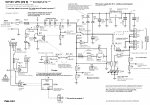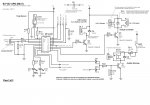Hi guys. I know this question probably comes up a lot - and I've read a few posts - but I am still a bit stuck 
My Picaxe is resetting intermittently only after 12 volt relays change state in my circuit (well, at least I think it’s the relays causing it), but I have most of the basic noise suppression components already connected!
Here are the facts: Picaxe (18M2) and relays are connected to the same power source, only the Picaxe is running off 5 volts and the relay off 12 volts (relay is a 12V coil type); Picaxe has a 0.1uF greencap across the power pins; Relay coils have a 1N4004 diode in parallel; The LM2940CT 5-volt ‘low dropout’ regulator I’m using is equipped with filter capacitors on both the input and output pins (in this case, a 0.47uF on input and 220uF on output – based on the manufacturer’s datasheet); power input is coming from a regulated power supply. – So I pass with most of the basics, right?
But it seems my circuit is lacking something else with regards to the relays. After performing some research, I guess my question is, would I be wasting my time with things like RC snubbers and Ferrite beads? Now, the problem with me trying these methods is that I don’t have an oscilloscope or anything like that (more importantly, I am not understanding the given “formulas” to work out the suitable values either), so would there be some sort of “guide values” I could try for a low power 12V circuit suffering with this sort of problem?
A friend mentioned I should try using Solid State Relays instead of the mechanical relays, but to be honest, they are a bit big, too expensive, and I don’t know a lot about them. I would much rather use the relays I have and just add a few smaller components here and there if I have to. Your thoughts? Thanks in advance
My Picaxe is resetting intermittently only after 12 volt relays change state in my circuit (well, at least I think it’s the relays causing it), but I have most of the basic noise suppression components already connected!
Here are the facts: Picaxe (18M2) and relays are connected to the same power source, only the Picaxe is running off 5 volts and the relay off 12 volts (relay is a 12V coil type); Picaxe has a 0.1uF greencap across the power pins; Relay coils have a 1N4004 diode in parallel; The LM2940CT 5-volt ‘low dropout’ regulator I’m using is equipped with filter capacitors on both the input and output pins (in this case, a 0.47uF on input and 220uF on output – based on the manufacturer’s datasheet); power input is coming from a regulated power supply. – So I pass with most of the basics, right?
But it seems my circuit is lacking something else with regards to the relays. After performing some research, I guess my question is, would I be wasting my time with things like RC snubbers and Ferrite beads? Now, the problem with me trying these methods is that I don’t have an oscilloscope or anything like that (more importantly, I am not understanding the given “formulas” to work out the suitable values either), so would there be some sort of “guide values” I could try for a low power 12V circuit suffering with this sort of problem?
A friend mentioned I should try using Solid State Relays instead of the mechanical relays, but to be honest, they are a bit big, too expensive, and I don’t know a lot about them. I would much rather use the relays I have and just add a few smaller components here and there if I have to. Your thoughts? Thanks in advance


